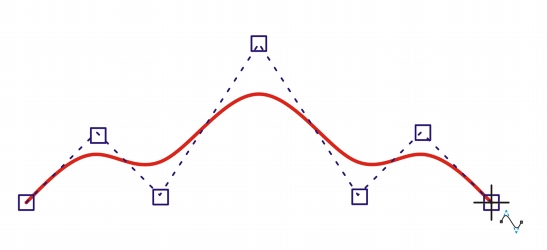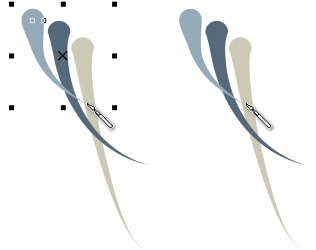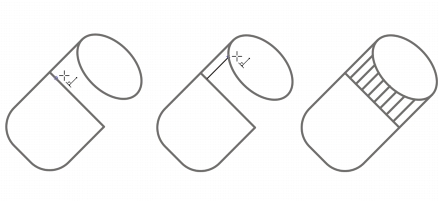
Quick links to procedures on this page:
• |
• |
• |
• |
• |
• |
• |
• |
You can draw many different kinds of lines, including straight lines, curved lines, lines that contain both straight and curved segments, and straight lines that are perpendicular or tangent to objects. In addition, you can draw straight or curved segments and then add one node at a time. You can also draw curved segments by specifying the width and height.
By using control points, you can easily shape a curved line and draw B-splines, which are typically smooth, continuous curved lines. B-splines touch the first and last control points and are pulled by the points in between. However, unlike the nodes on Bézier curves, control points don’t let you specify the points through which a curve passes when you want to align a curve with other drawing elements.
The control points that touch the line are referred to as “clamped”. Clamped control points function as anchors. The control points that pull the line but do not touch it are referred to as “floating”. The first and last control points are always clamped on open-ended B-splines. The points in between float by default, but you can clamp points if you want to create cusps or straight lines within the B-spline. You can edit completed B-splines by using the control points.

The path of a B-spline curve is determined by the control points you set.
Some lines have nodes and control points that you can manipulate to shape the lines as you draw. For information about node types, see Working with curve objects.
Corel DESIGNER provides preset lines that let you create thick strokes in a variety of shapes. After you draw a preset line, you can apply a fill to it. For information about applying fills, see Filling objects.
When drawing lines using the curve tools, you can hide the bounding box that displays around the lines once they are drawn. The curve tools include: the Linear Pattern tools, the Freehand tool, the 2-point line tool, the Bézier curve tool, the Pen tool, the Multi-point line tool, the B-spline tool, and the 3-point curve tool.

You can hide the bounding box to enhance the fluidity of drawing lines in quick succession.
| To draw a straight line |
1. |
Click the Curve tools button, and click the 2-point line tool
|
2. |
Point to where you want to start the line, and drag to draw the line.
|
As you drag, the length and angle of the segment appear in the status bar. |
You can constrain a two-point line to a straight vertical or horizontal line by
holding down Ctrl while you drag. You can change the angle of this line by
clicking Tools |
You can use snapping to specify the start points and endpoints of lines. For
information, see Working with precision.
|
| To draw a perpendicular line |
1. |
Click the Curve tools button, and click the 2-point line tool
|
2. |
On the property bar, click the Perpendicular 2-point line button
|
3. |
Click the edge of an object, and drag to where you want the line to end.
|
If you want to draw a line that is perpendicular to two objects, drag to the edge of the second object, and release the mouse button when the perpendicular snap point appears. |
To extend the line beyond the second object, hold down Ctrl when the perpendicular snap point appears, and drag to where you want the line to end. |

Drawing a perpendicular line
This procedure cannot be used for drawing a line that is perpendicular to the
baseline of a text object.
|
You can also drag from an existing curve to draw a perpendicular line.
|
| To draw a tangent line |
1. |
Click the Curve tools button, and click the 2-point line tool
|
2. |
On the property bar, click the Tangential 2-point line button
|
3. |
Click the edge of a curved segment in an object, and drag to where you want the
tangent line to end.
|
If you want to draw a line that is tangent to two objects, drag to the edge of the second object, and release the mouse button when the tangent snap point appears. When the quadrant snap point coincides with tangent snap point, the quadrant snap point appears. |
To extend the line beyond the second object, hold down Ctrl when the tangent snap point appears, and drag to where you want the line to end. |

Drawing tangent lines
The Tangential 2-point line mode can be used for drawing the sides of the
cylinder.
|
| To draw a curved line |
1. |
Click the Curve tools button, and click the Freehand tool
|
2. |
Point to where you want to start the curve, and drag to draw the line.
|
You can erase a portion of a freehand curve by holding down Shift and
dragging backward over the line before releasing the mouse button.
|
You can close an open curve object by clicking Arrange |
| To draw a curved line by specifying width and height |
1. |
Click the Curve tools button, and click the 3-point curve tool
|
2. |
Click where you want to start the curve, and drag to where you want the curve to
end.
|
The start and end positions appear in the status bar. |
3. |
Release the mouse button, and click where you want the apex of the curve to be.
|
As you position the apex, the length of the segment appears in the status bar. |
| To draw a B-spline |
1. |
Click the Curve tools button, and click the B-spline tool
|
2. |
Click where you want to start the line.
|
3. |
Click to set as many control points as you need to shape your line.
|
Control points float by default, but you can clamp control points to the line by pressing V while clicking. |
4. |
Double-click to finish the line.
|
Pressing Esc cancels the line instead of finishing it. |
If you add to a B-spline by selecting the first or last control point, the clamped
control point automatically changes to a floating control point as you draw the
new portion of the line.
|
You can change whether a control point is floating or clamped by holding
down V and clicking a control point with the Shape tool.
|
You can also add control points while you draw a B-spline by pressing
Spacebar instead of clicking.
|
By choosing Arrange |
| To draw a preset line |
1. |
Click the Linear pattern tools button, and click the Linear pattern preset
tool
|
2. |
Choose a preset line shape from the Preset stroke list box.
|
3. |
Drag until the line is the shape you want.
|
If you want to adjust the line width, type a value in the Stroke width box on the property bar. |
| To hide the bounding box when using curve tools |
1. |
In the toolbox, click one of the following curve tools:
|
• |
Linear pattern tools
|
• |
Freehand
|
• |
2-point line
|
• |
Bézier curve
|
• |
Pen
|
• |
B-spline
|
• |
Multi-point line
|
• |
3-point curve
|
2. |
Click the Bounding box button
|
When you hide the bounding box while working with one curve tool, the
bounding box remains hidden for all curve tools. For example, if you hide the
bounding box when using the Freehand tool, it remains hidden when you
switch to the Bézier curve tool.
|
You can also hide the bounding box when drawing with the curve tools by
clicking Tools |
|
|
Copyright 2013 Corel Corporation. All rights reserved.